An unexpected error occurred.
We’re sorry you have experienced this error.
Please try again later and, if the error persists, please use our contact form to report what you were trying to do when the error occurred. If possible, copy and paste into your message the URL of the page you were trying to reach.
Thank you.
